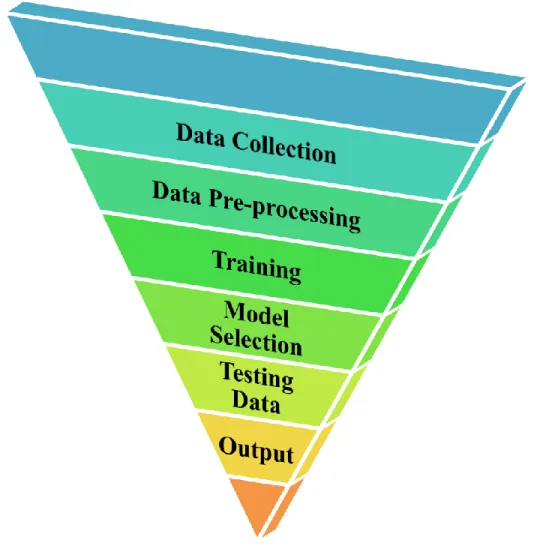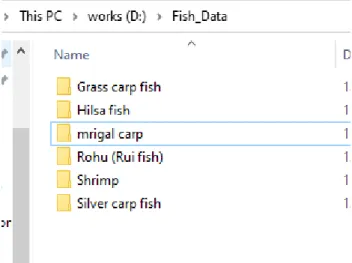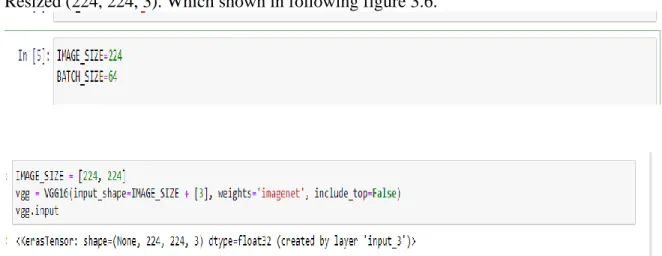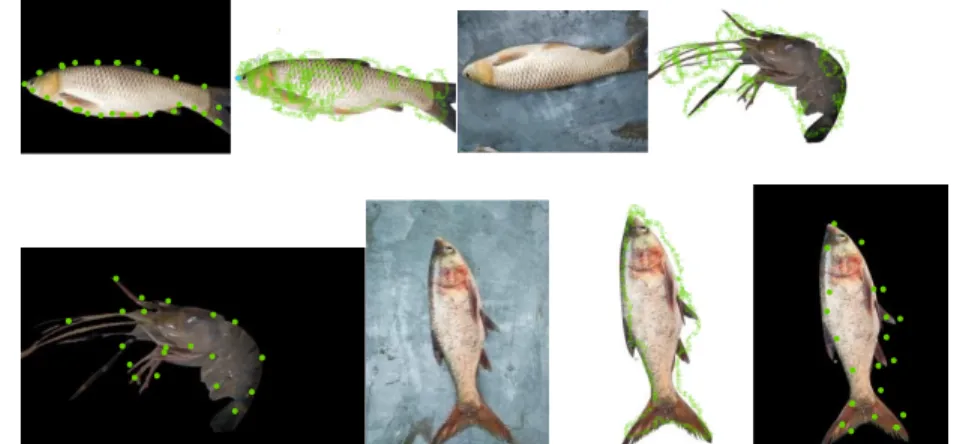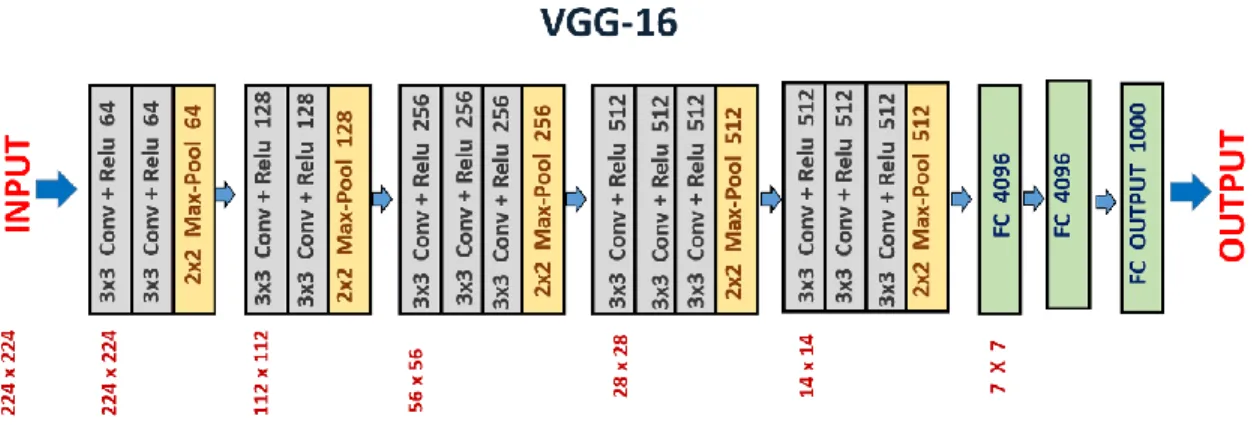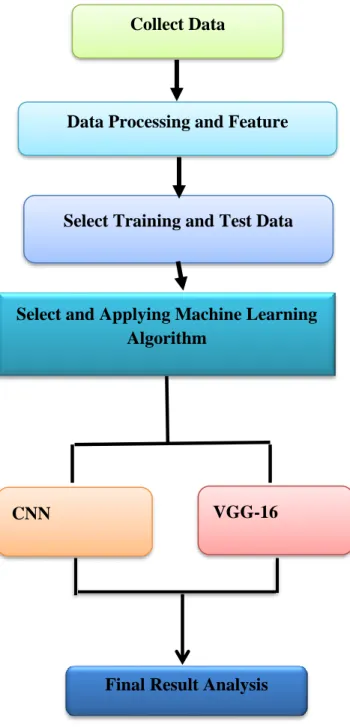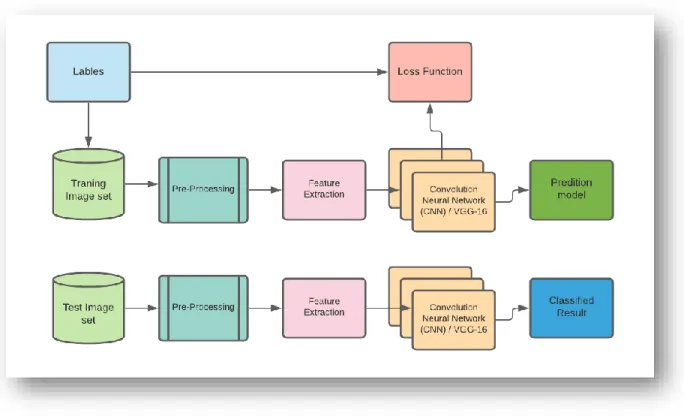FISH DETECTION BY MACHINE LEARNING APPROACH BY
ISRAT JAHAN URMI ID: 181-15-10799 MD SHAHRYAR PRODHAN
ID: 181-15-10676
This Report Presented in Partial Fulfillment of the Requirements for the Degree of Bachelor of Science in Computer Science and Engineering
Supervised By
Ms. Nazmun Nessa Moon
Associate Professor Department of CSE Daffodil International University
Co-Supervised By MD ABDUS SATTAR
Assistant Professor Department of CSE Daffodil International University
DAFFODIL INTERNATIONAL UNIVERSITY
DHAKA, BANGLADESH 2th JANUARY 2022
APPROVAL
This Project/internship titled “Fish Detection by Machine learning Approach”, submitted by Israt Jahan Urmi & Md Shahryar Prodhan, ID No: 181-15-10799 and 181-15-10676 to the Department of Computer Science and Engineering, Daffodil International University has been accepted as satisfactory for the partial fulfillment of the requirements for the degree of B.Sc. in Computer Science and Engineering and approved as to its style and contents. The presentation has been held on 02-01-2022.
BOARD OF EXAMINERS
______________
Dr. Touhid Bhuiyan Professor and Head
Department of Computer Science and Engineering Faculty of Science & Information Technology Daffodil International University
Chairman
________________________
Moushumi Zaman Bonny Assistant Professor
Department of Computer Science and Engineering Faculty of Science & Information Technology
Internal Examiner
Daffodil International University
________________________
Md. Mahfujur Rahman Senior Lecturer
Department of Computer Science and Engineering Faculty of Science & Information Technology Daffodil International University
Internal Examiner
_____________
Dr. Md Arshad Ali Associate Professor
Department of Computer Science and Engineering
Hajee Mohammad Danesh Science and Technology University
External Examiner
DECLARATION
We hereby declare that this project has been done by us under the supervision of Ms.
Nazmun Nessa Moon Associate Professor and co-supervision Md Abdus Sattar Assistant Professor, Department of CSE Daffodil International University. We also declare that neither this project nor any part of this project has been submitted elsewhere for award of any degree or diploma.
Supervised by:
Ms. Nazmun Nessa Moon Associate Professor
Department of CSE
Daffodil International University Co-Supervised by:
Mr. Abdus Sattar
Assistant Professor & Coordinator M.Sc Department of CSE
Daffodil International University Submitted by:
Israt Jahan Urmi ID: 181-15-10799 Department of CSE
Daffodil International University
Md. Shahryar Prodhan ID: 181-15-10676
Department of CSE
Daffodil International University
ACKNOWLEDGEMENT
First, we express our heartiest thanks and gratefulness to almighty God for His divine blessing makes us possible to complete the final year project/internship successfully.
We are grateful and wish our profound our indebtedness to Supervisor Ms. Nazmun Nessa Moon and Co-Supervisor Md Abdus Sattar, Assistant Professor, Department of CSE, Daffodil International University, Dhaka. Deep Knowledge & keen interest of our supervisor in the field of “Machine Learning and Data Mining” to carry out this project.
Her endless patience, scholarly guidance, continual encouragement , constant and energetic supervision, constructive criticism , valuable advice ,reading many inferior draft and correcting them at all stage have made it possible to complete this project.
We would like to express our heartiest gratitude to Prof. Dr. Touhid Bhuiyan and Head, Department of CSE, for his kind help to finish our project and to other faculty member and the staff of CSE department of Daffodil International University.
We would like to thank our entire course mate in Daffodil International University, who took part in this discuss while completing the course work.
Finally, we must acknowledge with due respect the constant support and patients of our parents.
ABSTRACT
In Bangladesh fish farming is already a major source of employment and many working facilities can be created through high-tech commercial fish farming systems. Even the unemployed educated people can also contribute to this business and create a lucrative business and earning opportunity for them. This “Fish Detection by Machine learning Approach” makes our life easy and increases our knowledge about fish. This project represents a model to detect and recognize local fishes of Bangladesh implementing image processing and neural networking approaches. The project work aims to apply computer vision and AI techniques so that people of the next generation can recognize Bangladeshi fishes as most of the young people in the city, have less idea to classify traditional and desi fishes. We implemented our custom Dataset consisting of 1250 sample images for the experiment method to measure out its credibility. In the proposed, model a sequential grassfire algorithm is used along with pre-processing techniques like noise cancelation, gray scaling, flood-fill method, binarization to detect and analyze the shape of fish. Then Further, to do classification and recognition of the detected fishes, convolutional neural network (CNN) and method of Visual Geometry Group (VGG-16) had been applied.
TABLE OF CONTENTS
CONTENTS PAGENO.
Approval i
Declaration iii
Acknowledgements v
Abstract vi
CHAPTER CHAPTER 1: INTRODUCTION
1-3 1.1 Introduction 11.2 Motivation 1.3 Rationale of the Study 1.4 Research Questions 1.5 Expected Output 1.6 Report Layout 2
2
2
3
4
CHAPTER 2: BACKGROUND
2.1 Introduction 2.2 Related Works 2.3 Research Summary 2.4 Scope of the Problem 2.5 Challenges 4-7 55
6
7
7
CHAPTER 3: RESEARCH METHODOLOGY
3.1 Introduction 3.2 Research Subject and Instrumentation
3.3 Data Collection Procedure
3.4 Data Pre-processing 3.5 Training
3.6 Machine Learning Algorithms 3.7 Statistical Analysis
3.8 Implementation Requirements
CHAPTER 4: EXPERIMENTAL RESULT AND DISCUSSION
4.1 Experiment Setup 4.2 Model Summary
4.3 Experimental Result and Analysis 4.4 Discussion
8-19 8 9 9
10 12 13 17 19
21-30
21 21 22
30
CHAPTER 5: SUMMARY, CONCLUSION, RECOMMENDATION, IMPLICATION FOR FUTURE RESEARCH
5.1 Summary of the Study 5.2 Conclusions
5.3 Recommendations
5.4 Implication for Further Study
31-32
31 31 32 32
REFERENCES APPENDIX
33 34
LIST OF FIGURES
FIGURES PAGE NO.
Figure 3.1: Methodology at a Glance 8 Figure 3.2: Fish Data 9 Figure 3.3: Image Folders 10 Figure 3.4: Import libraries 11 Figure 3.5: Data Location 11
Figure 3.6: Data Pre-Processing 12
Figure 3.7: Training data set 13
Figure 3.8: Convolutional layers apply 14
Figure 3.9: Convolutional layers apply 15
Figure 3.10: Very Deep Convolutional networks layers apply 16
Figure 3.11: Proposed Model Flowchart 18
Figure 3.12: Proposed Model Structure 19
Figure 4.1: Convolutional Neural Network (CNN) Algorithm Output 23 Figure 4.2: CNN Algorithm Model Loss Graph 25 Figure 4.3: CNN Algorithm Model Accuracy Graph 25 Figure 4.4: VGG-16 Model import libraries 26 Figure 4.5: Using VGG-16 Model Summarization 26 Figure 4.6: Visual Geometry Group (VGG-16) Algorithm Output 27
Figure 4.7: VGG-16 Algorithm Model Loss Graph 29
Figure 4.8: VGG-16 Algorithm Model Accuracy Graph 30
LIST OF TABLES
TABLE NAME PAGE NO.
Table 4.1: Accuracy Table 22
Table 4.2: Accuracy Table of CNN 24
Table 4.3: Accuracy Table of VGG-16 28
CHAPTER 1 INTRODUCTION 1.1 Introduction
Bangladesh has an appreciative geographic position having a diverse range of aquatic animals and the resources to sustain them the fishery's future. Fish is a favored company rice as a staple of the national diet, resulting in the adage “Maache-Bhate Bangali” (“Fish and rice make up a Bengali.”). One of the most productive and active businesses is the fishing industry which has the agrarian economy of Bangladesh in enormous potentiality for future development. Bangladesh's national GDP is 3.61 percent, while the agricultural GDP is above 24.41 percent (DoF, 2017).Fish is an excellent source of protein that we are accustomed to eating in our everyday meals. Regarding our country's current circumstances, some native freshwater species are rapidly getting rare due to environmental and other issues. River erosion and water pollution have become major concerns to freshwater fish. As a result, the majority of the new generation is unfamiliar with these species. If things keep on this way, the coming generation will be unaware of these fish. Hilsa fish, Rohu (Rui fish), Shrimp, Grass carp fish, Silver carp fish, mrigal carp are some remarkable fish in Bangladesh.
Our study attempts to create a deep neural network that can distinguish between conventional and dashi fish, as well as a Visual Geometry Group. Two contributions to the area of fish categorization are represented by the work presented in this study. The first is a study of how to employ data augmentation techniques, when categorizing fish scenes in a multi-class context utilizing general-purpose photos, multiple convolutional neural network (CNN) and visual geometry Group (VGG-16) architectures were considered for the feature extraction procedure. The production of a new, unique Dataset depicting scenes of six different fish types is the second contribution.
1.2 Motivation
We are motivated by this idea from the busy life of 21'st century modern people. We've seen that many people don’t know the fish name and quality properly. Urban areas’ people don’t have such the opportunity to watch very much fish in real life. Our main focus is solving background and variant problems using shape and color features in fish.
Classification of fishes becomes important after the advancement of machine learning as fish play an important part in Bangladesh's economy, and a good monitoring system will help to increase production. The technique can be also helpful for fisherman fish processing, packaging companies, and oceanographic resources. Therefore, we introduce a system that can detect the fishes and compare various methods. This consists of preprocessing with segmentation feature descriptor and n symbol to produce the final result. The utility used in the preprocessing layer to obtain two types of features, namely shape images and color images with removed.
1.3 Rationale of the Study
The number of fisheries research projects that use technological devices and feature extraction methods remains fairly small. Few research have been devoted in the field of fish identification, and fish from Bangladesh are extremely rarely found. The effect of our exploration on fish image processing has a long-haul impact on the Our exploration territories are:
➢ To give more accurate information on Bangladeshi fishes.
➢ To give individual fish information and its quality.
➢ To solve background and variant problems using shape and color features in fish.
➢ To introduce Bangladeshi fishes to the world.
1.4 Research Questions
✓ Does it predict an actual output by given sample data with the system?
✓ Can it classify 6 classes accurately using a machine learning algorithm?
✓ Does every algorithm work perfectly (yes/no)?
✓ Which algorithm gives more accuracy?
The biggest source of productivity and economic losses for fish producers is fish illness.
Fish illness diagnosis and health monitoring is a difficult problem for the manual approach of human vision. As an outcome, any prospective solution that is quick, dependable, and automated will pique people's interest in this problem. Image processing is now widely employed in the illness detection sector, particularly in people and plants, thanks to the present technological revolution, assisting human professionals in giving the appropriate therapy. Image processing technology can assist in improving the traditional way of obtaining accurate results.
We have used 2 algorithms such convolutional neural network and visual geometry group and we have obtained a good result, but the other algorithm didn’t give us good accuracy and feedback.
1.5 Expected Outcome
Digital image processing is the process of doing image analysis on a digital image using a matlab program. Appearance, translation, smearing, edge enhancement, identification, and other techniques are all discussed. The use of digital image processing in fisheries and other marine industries is still being researched by researchers. We're building a fish image recognition model for recognizing fish photographs in this study, and we're testing it using a range of machine learning algorithms. We used 90% training data and 10% test data to get a more accurate result. Our result is how much accurate it depends entirely on the training data set. Our machine learning system will be up and running soon, after completing all the needed procedure of our system. To get accurate output we have applied various strategies. We have got almost 100% accuracy from VGG-16 which we applied to this system.
1.6 Layout of the Report
Chapter 1:Introduction
In this section, we discussed our purpose for doing this research, as well as the study's rationale, research questions, and expected outcomes.
Chapter 2: Background
In this section, we will discuss regarding the related work of our research and comparative studies between our developed model and existing related model as well as the problems and challenges that we’ve faced.
Chapter 3: Research Methodology
In this section, we’ll speak about our research methodology, which means we'll talk about how we conducted our study and the terms we used.
Chapter 4: Experimental results and Discussion
In this section,we’ll talk about the outcomes of our study experiments. We'll discuss the outcomes we've obtained by applying machine learning algorithms to the data we've gathered.
Chapter 5: Summary, Conclusion, Recommendation, and Implication for Future Research
In this section, we’ll talk about the summary, conclusion, suggestion, and scope of our research's future development.
CHAPTER 2 BACKGROUND
2.1 Introduction
Fish have been carefully chosen across the world because of their value as food, decorative, a vital component of biodiversity, recreational opportunities, and scientific research. The exact diagnosis of the types of fish is crucial in all research. For analyzing fish harvest and reserves, as well as maritime labeling, accurate identification is essential. Fish taxonomy, often known as fish identification, is a complex task that requires a thorough study of fish physical traits and classification systems. Few efforts have been done in the field of fish identification, and fish from Bangladesh are seldom found.
In this section, we'll go through our linked project overview as well as the research's problems. Extensive research publications relating to our activity in the related job area will be discussed. In the summary portion, we'll go through the basics of our study, and then in the challenge section, we'll talk about how to enhance accuracy.
2.2 Related Works
This study presents a fish detection system based on machine vision. This experiment used six different fish species and fourteen different characteristics. For feature selection, they employed PCA. They used three classifiers to make an excellent identification of fish.
SVMs, one of the classifiers used, performed well, obtaining 94.2 percent accuracy. Deep learning produces virtually human-level performance on such computer vision tasks. They are employing high resolution and some specific angles to recognize photographs without any detection in this study. [1]
In this research, they have proposed a method that can identify real Hilsa fish and dummy(lookalike) Hilsa fish. They are the first to do research on identifying original
they have used several deep learning-based models. Then, the performance has been compared between them. Among those models, DenseNet201 achieved the highest accuracy of 97.02%.[2]
The authors developed a neural network model to identify fish in this research. The data augmentation strategy was used to provide adequate datasets to help the training process.
To overcome the overfitting problem, the dropout technique was chosen. Furthermore, the loss function was improved in order to update the network's parameters. Using these methods, both the training time and the training loss were minimized. They build their data set on real-world ocean water conditions. Refine the loss function and other parameters in CNN to find a solution that works for fish detection. Their solution is aimed at an embedded system for AUV design that incorporates all available improvements.[3]
They were categorized our own dataset of 400 photos using SURF and CNN (Convolutional Neural Network) in this thesis to discover and distinguish native Bangladeshi fishes. During the CNN image classifier's training phase, it obtains 90.9 percent training accuracy and loses 23.7 percent.[4]
They utilize a smartphone software to detect fish in real time, without using the internet.
The user is given more information about the fish once the species has been identified.
Using a deep learning network, a fish may be recognized even if part of it is obscured. In terms of brightness variations, the DNN is likewise quite resilient. The DNN can deal with rotated photos since the original images were enhanced during the training process.
Furthermore, the DNN can distinguish fishes even when they are displayed on paper or on a computer screen.[5]
2.3 Research Summary
Our examination work is developing a model for classifying fishes using machine learning algorithms and finding out which can be seen in future years using some different and effective algorithms of machine learning. Some related works were done using different
types of algorithms over their different types of collected data. Fish identification has received little attention, and fish from Bangladesh are rarely discovered. Someone has used their customize data, someone has used online resources using different techniques. We work with our customized data set.
We have used 2 algorithms to find out the accuracy level of our predictive model. The higher the accuracy the better will be the system.
2.4 Scope of the Problem
In every research, there can be a scope of the problem. So, there is no exception in our work too. Our collected data should be appropriate, and our data set should be smooth to do work with. We need to train our collected data properly while working with algorithms.
If we can’t do this properly our output won’t be appropriate and won’t be like the real-life scenario. If we want to reduce the problem we should work properly and carefully.
2.5 Challenges
No task can be accomplished without challenges. While doing any work, challenges could come in any step of the work. In our research the main challenge we had to face while collecting data from the local market. Data collection is the biggest challenge to get our predicting accuracy. We collected data from the Bangladeshi local market in this pandemic situation. There have no collected data on Bangladeshi fish in online resources properly which is helpful for our project. As a result, we went to many local markets and fish Bazar to collect data manually and then we store it in the pdf file on our PC. Algorithm selection is also a challenge for us. Therefore, a different algorithm has been applied to the proposed architecture. Finally, the implementation process has been established to get accurately predicted values. Several challenges were rising according to the working procedure.
CHAPTER 3
RESEARCH METHODOLOGY
3.1 Introduction
In this section, we'll go over our research methods and procedures in detail. This workshop will also cover field study tools, data collecting, study issue, pre-processing, analysis, mentoring, verification, and execution. Which shown in following figure 3.1.
Figure 3.1: Methodology at a Glance
3.2 Research Subject and Instrumentation
In our research for fish image recognition, we are doing this using some different machine learning algorithms. So, our research subject is - A Comparative Study on Fish Image Detection Using Machine Learning Algorithm.
We see that the examination's most important component is information. Finding spectacular data and a fantastic technique or model for our research job is an extremely important component for an expert. We'll also need to go at similar test papers. At that moment, we must choose between a few options.:
➢ Which information should be gathered?
➢ How can you be sure that the information we've gathered is correct?
➢ What's the best way to arrange each type of data?
➢ How should each type of information be labeled?
3.3 Data Collection Procedure
We used data that we customized ourselves, we collect from Bangladeshi local fish market, for the purpose of creating an open-source dataset that might potentially aid future computer vision research. This hypothesis, as a method of image processing, is a fair way to develop a dataset that will be shared while honoring the content creators. Unfortunately, the number of photographs we gather manually is limited, which means that datasets may be smaller. The Fish Dataset is a collection of pictures developed as part of this project.
Which shown in following figure 3.2.
The dataset was created, the various images are collected and saved in the local disk which contains weather depicting images. The dataset was labelled by identifying objects in the image such as Hilsa fish, Rohu (Rui fish), Shrimp, Grass carp fish, silver carp fish, mrigal carp.
The dataset features 6 different classes of fishes collected from the above said different local markets however, because this is real-world data, any fish classification system must be capable of dealing with it. The validation pictures are included in the training set, which contains roughly 1250 tagged photos. Images do not have defined dimensions, and photographs come in a variety of sizes. There are no borders on the images. Each image has only one fish category and is saved in a separate folder as of the labeled class. The images are saved in folders as shown in the following figure 3.3.
Figure 3.3: Image Folders
3.4 Data Pre-processing
First, we must import the libraries that will be used in this system. Which shown in following figure 3.4.
Figure 3.4: Import libraries
Read image: We created a method for extracting picture folders into arrays and then stored as a variable, the link to our picture collection. Which shown in following figure 3.5.
Figure 3.5: Data Location
Resize image: We need to specify a minimum size for all photos fed to our AI algorithms because the size of the pictures shot by the camera and sent to our AI algorithms changes.
Original size (360, 480, 3) etc. — (width, height, no. RGB channels)
Resized (224, 224, 3). Which shown in following figure 3.6.
Figure 3.6: Data Pre-Processing
3.5 Training
We centered our Visual data by eliminating the same per mean data point calculated on the train set. In our data augmentation for training, we apply random resizing, vertical rotations, luminance, intensity, and chromatic disturbances, as well as arbitrary pinching. Which shown in following figure 3.7.
Figure 3.7: Training data set
3.6 Machine Learning Algorithms
Because of their established accuracy rates, we created a methodology using the convolutional neural network (CNN) and Visual Geometry Group (VGG-16) Classifier algorithms on the experimental data set. All Python algorithms and libraries rely on NumPy, Pandas, and Matplotlib.
Algorithms and Technique
CNN: Convolutional neural networks (often referred to as ConvNets) are a form of neural network used to analyze visual input. Convolutional networks are multilayer perceptron types that have been regularized (fully connected networks). The network's application of the convolutional mathematical formula gave it the name "convolutional neural network". Convolution is a type of linear process that is specialized.
Convolutional networks are simple neural networks with at least one layer that uses convolution instead of ordinary matrix multiplication. An inlet and outlet layer, as well as numerous hidden layers, compensate a deep neural network. The consist of convolutional layers are capable of approximating that convolve with doubling or another scalar product. Additional convolutions such as pooling layers, completely connected layers, and normalizing layers are immediately followed by the input signal and final convolution and are alluded to as hidden units because their components of the system are obscured by the activation function and final pooling layers.
Backpropagation is frequently employed in the final inversion to improve the final result's weighting. Which shown in following figure 3.8.
Figure 3.8: Convolutional layers apply
Convolutional: A tensor with the shape (number of images) x (image width) x (image height) x (number of images) x (number of images) x (number of images) x (number of images) x (number of images) x (number of images) x (number of images) x (number of images) x (number of images) x (number of images) x (number of images (image depth).
x (number of images) x (feature map width) x (feature map height) x (number of pictures) x (number of images) x (number of images) x (number of images) x (number of images) x (number of images) x (number of images) x (number of images) x (number of images) x (number of images) x (number of images) x ((feature map channels). The following qualities should be included in a convolutional layer in a neural network:
• Fully - connected cones are characterized by their width and length in a neural network (hyper-parameters).
• The service's total amount of upstream and downstream channels (hyper-parameter).
• The size of the network in the receptive field (depth) must be equal to the context of the Linear combination (input channels).
Pooling: To accelerate up the fundamental computing, convnets may add national or global pooling layers. By merging the responses of neuron groupings at one stage into a nerve cell at the next layer, pooling layers minimize the dimensionality of data. Distinct, possibly two or two, are linked in local pooling. The convolutional layer's neurons are
all affected by global pooling. A maximum or average can also be computed via pooling.
In max pooling, the greatest value from each cluster of neurons from the preceding layer is utilized. The approximate amount off each constellation of synapses as from previous layer is used in batch normalization.
Fully Connected: Each cell in one level is associated through each perceptron in bindable layers. It works in the same way as a standard inter perceptron neural network in theory (MLP). To categorize the photos, the compressed grid is sent via a fully connected layer.
Receptive Field: Each synapse in a cnn architecture takes inputs from a certain lot of sites in the tier above it. Each cell in a fully linked layer receives information from all preceding layer components. The neurons of a convolutional layer only obtain information from a small portion of the preceding stage. A square-shaped subarea is the most common. The region in which a cell receives its input is known as the receptive field. As a result, the receptive field of a completely linked layer is the entire previous layer. The receptive area of a convolutional layer is smaller than the outer surface area of the layer before it. Which shown in following figure 3.9.
Figure 3.9: Convolutional layers apply
Weights: In a neural network, each neuron evaluates a final output by applying a formula to the input parameters from the previous layer's receptive field. A matrix of weights and a bias decide the algorithm that is used to the input data (typically real numbers). In a neural network, learning happens by iteratively altering them .biases and weights. Filters are made up of a set of weights and a bias that represent the input's characteristics.
Very Deep Convolutional networks (VGG): VGGNet was created by Oxford's Visual Geometry Group and won the ImageNet ILSVRC-2014 competition. The VGG architecture is made up solely of 3x3 Convolutional and MaxPooling layers, with a fully linked block at the end. For public usage, the pretrained model is provided in Keras, TensorFlow, Caffe, Torch, and a number of other popular deep learning libraries.
They demonstrated the impact of cnn model thickness on efficiency in a huge image recognition situation in the original study. They employed extremely tiny (3x3) convolution filters throughout the design and demonstrated a considerable improvement over prior-art setups by expanding the depth to 16-19 hidden layers. Their discoveries served as the foundation for their team's ImageNet Challenge 2014 entry, which placed first and second in the localization and classification events, and so on. They've made their two most successful ConvNet models freely available for others to utilize. Which shown in following figure 3.10.
Figure 3.10: Very Deep Convolutional networks layers apply
Architecture of VGG and CNN Layers:
• Convolution: Convolutional layers convolve around the picture to distinguish edges, lines, blobs of color, and other visual components. The number of channels, frequency response, speed, buffer, and initiation functions are all hyperparameters for inducing non-linearity in convolutional layers.
• MaxPooling: By erasing part of the pixels from the image, pooling layers reduces the dimensionality of the image. MaxPooling replaces a n × n region with the maximum pixel value from that area to down sample an image.
• Dropout: Dropout is a simple and efficient strategy for preventing overfitting of the neural network during training. Dropout is achieved by keeping a neuron active only when it has a probability of p and setting it to 0 otherwise. As a result, the network is forced to avoid learning duplicate data.
• Flatten: Before being transmitted to the Dense layers, the output of the convolution layers is flattened.
• Dense: Dense layers are standard fully connected networks that utilize an activation function to translate the scores of convolutional layers into the right labels (SoftMax used here) The configuration (number of filters) used in the VGG-16 and VGG-19 variants of the design, as seen in the table below, is shown in the two far right columns.
3.7 Statistical Analysis
In our dataset, it contains 1250 image belonging to 6 classes. Where 353 image of Hilsa fi sh, 331 image of Rohu (Rui fish), 131 image of Shrimp, 160 image of Grass carp fish, im age of 124 Silver carp fish, 108 image of mrigal carp. Here, in our model we selected 90%
train data and 10% test data. To apply machine learning algorithm such as (Convolutional Neural Network (CNN) and Visual Geometry Group (VGG-16)) we have tried to find out
better accuracy in our model. In this Figure 3.11, we have shown that dataset flowchart an d how we use the dataset for proposed model. Which shown in following figure 3.11.
Figure 3.11: Proposed Model Flowchart
In this diagram, we demonstrate how we conducted our research in more depth. We can see how to go toward our goal step by step in this diagram 3.12.
Collect Data
Data Processing and Feature
Select Training and Test Data
Select and Applying Machine Learning Algorithm
Final Result Analysis VGG-16 CNN
Figure 3.12: Proposed Model Structure
3.8 Implementation Requirements
• Python 3.7
Python 3.7 is a version of Python. It's an elevated programming language that employs a great deal of abstraction. It is used by the majority of researchers to conduct their research.
It is a strongly regarded programming language for AI-related work, and the ease with
which it can be learned and comprehended has made it extremely renowned amongst new generation of programmers.
• Jupyter Notebook
The Jupyter Notebook is a free, open-source web application that allows data developers to explore and share documents that include live script, formulas, analytical output, graphs, and other multimedia features, and also narrative text.
• Hardware/Software Requirements
❖ An Operating System (Windows 7/8/10 or above)
❖ A Web Browser (Preferably: chrome /Microsoft Edge/Mozilla Firefox)
❖ A Hard Disk (Minimum 4 GB)
❖
A Ram (More than 4 GB)CHAPTER 4
EXPERIMENTAL RESULT AND DISCUSSION
4.1 Experimental Setup
We gathered the data first in order to use the model and run the code. The following is the system:
• We acquired photographs from the Bangladeshi local fish market since we were working with fish images.
• The dataset features 6 different classes of fishes collected from the above said different local markets. Each image has only one fish category and is saved in a separate folder as of the labeled class.
• We've also used Google Forms to collect information online.
• After we've labelled the data, it's ready to be used in other ways.
• At that point, we have finished and standardized the information so we can start the preparation.
• At that point, our data has been preprocessed.
4.2 Model Summary
Fish observation is an important part of our job since it helps us make decisions and identify native fish. We have a propensity to disturb six kinds of fish from all local seafood throughout this task, including Hilsa fish, Rohu (Rui fish), Shrimp, Grass carp fish, Silver carp fish, and mrigal carp. To put it another way, these fish are rarely encountered at native fish markets that aren't regulated by the Bangladeshi government. The color, shape, size, and texture of these fish vary. As a result, the alternatives must be compelled to be chosen by taking these into account. In our study, we used all of those variables. These have helped us to be more precise in our job. Indeed, based on our investigation into other similar works, we've discovered that utilizing all of the parameters yields the most successful outcomes
4.3 Experimental Result and Analysis
We applied a variety of calculations after data processing to distinguish forecasts in the work holder. We'll quickly go over the results of several computations. To determine the precision of our model, we used our overall highlights, which we extracted from reading numerous papers, and did several AI computations. We were able to attain a high degree of accuracy, with an average accuracy of above 100%.We also used a person's data with our algorithm to assess our prediction level., and we noticed that depending on the data presented, the computer can easily predict results.
We have got an almost same different type of accuracy by using Convolutional Neural Network (CNN) we have got 0.80 and by using Visual Geometry Group (VGG-16) Classifier we have got 1.00 accuracy that has been shown in Table 4.1:
Table 4.1: Accuracy Table:
Algorithm Name Accuracy
Convolutional Neural Network (CNN) 80%
Visual Geometry Group (VGG-16) 100%
CNN:
The accuracy score was 80 percent, while the recognition rate was 77 percent. When there were numerous fish in a single image, the localization job failed because it was designed to detect only one item of image enhancement is the process. The presents the outcomes obtained with this ultimate heterogeneous network topologies and training parameters:
Accuracy of Training: 77%
Accuracy of Validation: 80%
In Figure 4.1, we can see the CNN Classifier algorithm output:
Figure 4.1: (CNN) Algorithm Output
The accuracy of CNN model algorithm shown in table 4.2.
Table 4.2: Accuracy Table of CNN:
Training Loss Training Accuracy Validation Loss Validation Accuracy
1.6937 0.2892 1.6829 0.30
1.6716 0.3548 1.6207 0.35
1.6300 0.3548 1.5230 0.36
1.5442 0.4213 1.4010 0.57
1.4139 0.4765 1.0813 0.71
1.2686 0.5235 0.9247 0.69
1.1453 0.5634 0.7977 0.81
1.0179 0.6186 0.8311 0.69
0.9224 0.6759 0.6603 0.81
0.6775 0.7735 0.5725 0.8033
Evaluating the CNN Model Performance:
Model loss: In Figure 4.2, we can see the CNN Classifier algorithm Loss Graph:
Figure 4.2: CNN Algorithm Model Loss Graph
Model Accuracy: In Figure 4.3, we can see the CNN Classifier algorithm accuracy Graph:
Figure 4.3: CNN Algorithm Model Accuracy Graph
VGG-16:
The Accuracy of Training was 100%, and the Accuracy of Validation was also 100%. Now it’s time to see our model and the output result :
Visual Geometry Group (VGG-16) Library: In Figure 4.2, we can see the VGG-16 Model import libraries:
Figure 4.4: VGG-16 Model import libraries
Figure 4.5: Using VGG-16 Model Summarization
In Figure 4.6, we can see (VGG-16) Classifier algorithm output:
Figure 4.6: (VGG-16) Algorithm Output
The accuracy of VGG-16 model algorithm shown in table 4.3.
Table 4.3: Accuracy Table of VGG-16:
Training Loss Training Accuracy Validation Loss Validation Accuracy
1.5008 0.5832 0.3265 0.8654
0.2471 0.9257 0.0487 1.0000
0.0784 0.9791 0.0359 0.9808
0.0407 0.9927 0.0351 1.0000
0.0250 0.9979 0.0267 1.0000
0.0248 0.9958 0.0170 1.0000
0.0168 1.0000 0.0318 1.0000
0.0148 0.9990 0.0131 1.0000
0.0121 0.9990 0.0264 1.0000
0.0102 1.0000 0.0170 1.0000
Evaluating the VGG-16 Model Performance:
Model Loss: In Figure 4.7, we can see (VGG-16) Classifier algorithm model loss graph:
Figure 4.7: VGG-16 Algorithm Model Loss Graph
Model Accuracy: In Figure 4.6, we can see (VGG-16) Classifier algorithm model accuracy graph:
Figure 4.8: VGG-16 Algorithm Model Accuracy Graph
4.4 Discussion
Our dataset and mode have been updated. As a result of the updates, we now know that this classifier can be used to predict whether or not a dataset is accurate over a wide variety of different datasets. We've had some success describing the exactness of 100% of impact forecasts.
The model makes it helpful to think about just as discover the result appropriately.
CHAPTER 5
SUMMARY, CONCLUSION, RECOMMENDATION, IMPLICATION FOR FUTURE RESEARCH
5.1 Summary of the Study
Using the VGG-16 and CNN (Convolutional Neural Network) algorithms, we developed this research project to detect and recognize native Bangladeshi fishes. A comparison with certain previously released accidental study results is required to evaluate the quality of our suggested approach in distinguishing native species. Furthermore, the lack of a consistent database of fish samples makes it difficult to make an accurate assessment of the quality of different methodologies. We gathered information on a variety of fish from a local fish market in Bangladesh. Following that, we meticulously applied data pre- handling decisions in order to make them suitable for the system.
5.2 Conclusion
In both scientific and technical fields, image processing is increasingly frequently used. To acquire more precise findings, image processing technology is being applied to improve the manual approach technique. We used the VGG-16 and CNN (Convolutional Neural Network) algorithms to recognize and classify native Bangladeshi fishes in this study, and we had a bespoke dataset of 1250 photographs to classify. For recognition, we initially utilized the CNN algorithm and measured its accuracy, then switched to the VGG-16 method and measured its accuracy as well. CNN's accuracy ranges from 77 to 80 percent, with grass carp fish species having the best accuracy and shrimp having the lowest. During the training phase of the VGG-16 image classifier, it achieves a training accuracy of 100
% and a loss of 0.0102. The VGG-16 algorithm will perform better on our dataset.
5.3 Recommendations
So numerous significant advances can be appeared by enormous data investigation like discovering the reason of discouragement in occupation area. The eventual fate of this world lies in Artificial Intelligence. AI is a significant part of that innovation. So, creating frameworks utilizing AI to tackle our issues is basic to the progression of the present developments. So, technologists and specialists need to zero in on this area. Information classifier is quite possibly the main piece of AI. It has the potential to transform the way people think about the item in general.
5.4 Implication for Further Study
❖ To make our analysis more efficient, we will deal with additional data.
❖ We will utilize more deep learning techniques in the future.
❖ We are now detecting the item from a still image with our existing
technology. We'd want to improve it a bit further and make it work with a real-time image.
❖ In our current system, we will only detect a fish image, in the future, we will detect fish diseases.
❖ We'll enhance the sample data to see whether we can detect the fishes more precisely.
REFERENCES
[1] Israt Sharmin, Nuzhat Farzana Islam , Israt Jahan , Tasnem Ahmed Joye , Md. Riazur Rahman , Md.
Tarek Habib. Machine vision based local fish recognition, © Springer Nature Switzerland AG 2019 M:
Received: 10 June 2019 / Accepted: 24 October 2019 / Published online: 1 November 2019.
[2] Jannatul Ferdous , Ani Abdur Rahman , Zakia Zaman Department of Computer Science and EngineeringDaffodil International UniversityDhakaBangladesh.Fake Hilsa Fish Detection Using Machine Vision,Published Conference / Journal :M Conference paper First Online: 18 May 2021, Springer Nature Switzerland March 22
[3] Suxia Cui, Yu Zhou, Yonghui Wang, and Lujun Zhai.Fish Detection Using Deep Learning,Department of Electrical and Computer Engineering, Prairie View A&M University, Prairie View, TX 77446, USA,Accepted04 Nov 2019, Published23 Jan 2020, Hindawi
[4] M. I. Pavel, A. Akther, I. Chowdhury, S. A. Shuhin and J. Tajrin. Department of Computer Science and Engineering, BRAC University, Dhaka, Bangladesh.Detection and Recognition of Bangladeshi fishes using surf and convolutional neural network. Received: 15 April 2019 Final Accepted: 17 May 2019 Published: June 2019, International Journal of Advance Research (IJAR)
[5] Sameerchand Pudaruth, Nadeem Nazurally, Chandani Appadoo, Somveer Kishnah, Munusami Vinayaganidhi, Ihtishaam Mohammoodally, Yameen Assot Ally and Fadil Chady University of Mauritius,A Mobile Application for Fish Species Recognition using Image Processing Techniques and Deep Learning. Received ## Jul. 2020, Revised ## Sep. 2020, Accepted ## Nov. 2020, Published ## Jan.
2021, International Journal of Computing and Digital Systems.
[6] E A Awalludin1, T N T Arsad1 and W N J Hj Wan Yussof2, A Review on Image Processing Techniques for Fisheries Application.Journal of Physics: Conference Series, To cite this article: E A Awalludin et al 2020 J. Phys.: Conf. Ser. 1529 052031
[7] https://medium.com/learning-machine-learning/multi-class-fish-classification-from-images-with- transfer-learning-using-keras-335125637544 Tahsin Mayeesha ,jan 30,2018.
[8] https://www.geeksforgeeks.org/vgg-16-cnn-model/ , GeeksforGeeks - 27 Feb, 2020.
[9]https://www.geeksforgeeks.org/introduction-convolution-neural-network/ , GeeksforGeeks - 25 Nov,
[10] https://towardsdatascience.com/a-comprehensive-guide-to-convolutional-neural-networks-the-eli5- way-3bd2b1164a53 , Sumit saha - Dec 15,2018.
[11] https://www.analyticsvidhya.com/blog/2021/05/convolutional-neural-networks-cnn/ , Manav Mandal – May 1, 2021
APPENDIX RESEARCH REFLECTION
During project activities, we have faced several problems. But some problems were major among them. One is selecting the best algorithm, creating survey questions and another is data collection. Before working with visual geometry group (VGG- 16), we tried many ways to solve our problems and we failed to get the best output.
To collect data, we faced too much difficulty. Because, in Covid-19 pandemic situation, locally data collection is time-consuming and too much difficult for students. So, we have to collect some data from online sources. And after a long time and a lot of attempts and hard work we got to succeed.
